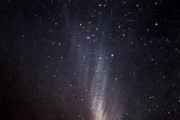Viewings: 5476

In February and March 1744 in the scientific circles of Petersburg Academy of Sciences there was great agitation. These days in the sky was observed wonderful bright comet with a huge tail. With special interest was watching the comet, for her moving among the stars, and changing the appearance of the then young scientist M. Century Lomonosov.
This comet was exceptional sight: her misty "appendage" stretches almost half of the sky and consisted of several separate tailings.
Most comets have highly elliptical orbits and the greater part of his time treatment they are in the outer regions of the Solar system, coming close to the Sun only for a short time.
The difference between comets and asteroids are a bit controversial. The main difference, it seems, is that comets have more elongated orbits.
For a long time people knew nothing about the nature of comets. They appeared so suddenly and mysteriously, and the view is so unusual that superstitious minded people saw them as harbingers of all the troubles and disasters; war, plague, cholera, hunger.
In the XVI century astronomer Tycho Brahe in many other researchers have found that comets are far beyond the earth's atmosphere, and even much further than the Earth's Moon; they are moving in the space of about the same great distance from the Earth as a planet.
Later, at the end of the XVII century, the brilliant scientist Isaac Newton, assuming that comets, and planets and their satellites, obey the law of gravity, for the first time determined the path around the Sun one of comets. It was the comet of 1680 was that her way is an infinitely extended curve - a parabola. Passing near the Sun, this comet was borne in interstellar space, and more have ever seen.
Friend and pupil of Newton E. Halley defined path around the Sun 24 comets. This laborious work has led to interesting results; it turned out that three comets observed at intervals of about 76 years old, moved by almost coincided ways.
Having carefully studied this question, galley with full confidence stated that in fact there were not three different comets and the same. Halley calculated, within what time this comet will be visible again, and predicted its appearance in 1758. His prediction has been brilliantly confirmed. So it was proved that the motion of comets is subject to the same laws as the movement of other celestial phone a Relatively short period of circulation of Halley's comet (about 76 years) gave the opportunity to observe it during successive appearances.
Sketches of this comet, made in ancient times, show that the comet and then looked exactly the same as in the era of Halley.
What are the main features of the structure of the comet? The brightest part of it - it head". It is similar to the condensed, nebulous cloud brightness is increased to the middle. Here is sometimes seen core" the head of the comet-like star. From the head of the comet comes out in the form of weak luminous band "tail". Occasionally observed comets exceptionally bright: they Shine surpassed Shine Venus or Jupiter.
Until the comet is far from the Sun, she has no tail. The tail appears and begins to grow closer to the comet to the Sun, and he usually directed away from the Sun.
The tails of comets vary in length and form. Some of comet tails stretched across the sky; in others they were barely noticeable. For example, the comet's tail 1744 had a length of 20 million km, and the tail of the comet of 1680, he stretches for 240 million km you Can see that if given the size substance of the comet's tail would have a density of at least such as water, the force of gravity would cause not only the planet but also the Sun to revolve around this comet. Comets with tails would be the most massive bodies of the solar system. In fact, the head and in particular the tails of comets consist of extremely rarefied matter. The mass of comets so insignificant in billions of times less than the mass of the Earth, and the attraction exerted by a comet in the Sun and the planet is so small, that it is even impossible to detect.
In may 1910, the Earth passed through the tail of Halley's comet. In the movement of Earth has been no change. The tails of comets so transparent that through them visible stars. Thus, the comet's tail may only consist of particles of gas that is in a state of severe depression, or from the smallest particles of dust, or of a mixture of gas and dust.
The nucleus of the comet is hard and dense. It consists of a mixture of frozen gases and dust, and, apparently, stone blocks. Diameters solid cometary nuclei are from several meters to several kilometers. Therefore, the collision of the comet's nucleus with Earth is not threatened last no danger. Upon entering the earth's atmosphere frozen gases quickly evaporates, and the kernel will only fragments, which can not harm the Earth. So, Earth's collision with a comet's not terrible, and it can happen very rarely - once for tens or hundreds of thousands of years.
Comets are now open to the sky every year, sometimes even several comets per year. However, many of them can be seen only through a telescope, and how foggy spots.
















